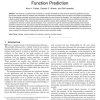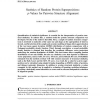55 search results - page 2 / 11 » An error model for protein quantification |
TCBB
2010
13 years 3 months ago
2010
—The literature on protein function prediction is currently dominated by works aimed at maximizing predictive accuracy, ignoring the important issues of validation and interpreta...
JCB
2008
13 years 5 months ago
2008
Quantification of statistical significance is essential for the interpretation of protein structural similarity. To address this, a random model for protein structure comparison w...
BMCBI
2008
13 years 5 months ago
2008
Background: Protein structure prediction and computational protein design require efficient yet sufficiently accurate descriptions of aqueous solvent. We continue to evaluate the ...
BMCBI
2007
13 years 5 months ago
2007
Background: Predicting protein complexes from experimental data remains a challenge due to limited resolution and stochastic errors of high-throughput methods. Current algorithms ...
BMCBI
2008
13 years 5 months ago
2008
Background: Protein structure analysis and comparison are major challenges in structural bioinformatics. Despite the existence of many tools and algorithms, very few of them have ...


